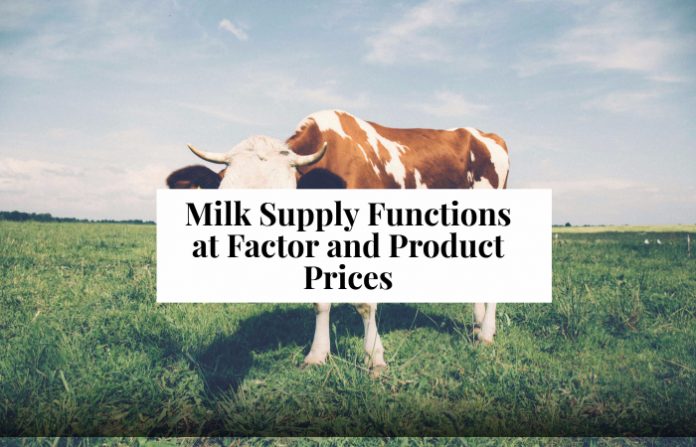Introduction:
The prosperity of any nation is closely intertwined with the socio-economic and health status of its people. And, raising the milk production to satisfy the prescribed levels of per capita consumption is an imperative need in this direction. However, this is no mean task. Nevertheless, there is a silver lining in the emerging improved technologies that, when optimally utilised, can truly transform the dairy sector and step up milk production to desired levels.
With increase in demand for milk it also becomes necessary to increase the supply. Price being one of the important determinants of supply, it is important to explore the possibilities of increasing milk production through price changes. Supply relationships are of immediate concern to outlook workers and other agricultural specialists who furnish information on which farmers base decisions. A knowledge of supply functions would allow marketing firms to anticipate more accurately the timing and magnitude of future commodity supplies, leading to marketing efficiencies and lower consumer prices. Agricultural supply relations and elasticity also are vital for policy decisions, particularly those dealing with production control programs and price support levels for farm products. Very few empirical studies have been carried out to determine the supply of milk as a function of prices. There is, therefore, a necessity to study the supply response of milk which would considerably reduce the area of imperfect knowledge in this domain. The study of Sankhyan and Miglani (1973) was an attempt to derive short-run supply functions for buffalo milk production in Ferozepur district of Punjab and subsequently by Dhaka (1981) for different categories of milk producers in Alleppy and Idukki districts of Kerala. The present investigation had also made an attempt to study the supply functions for Murrah buffaloes and Crossbred cows maintained by milk producers of Bulandshahr district of Uttar Pradesh under different market infrastructure.
The specific objectives of the study were:
-
To determine the functional relationships between the output of milk and the fixed cost and variable cost,
-
To estimate the price elasticity of supply, and
-
To estimate the supply functions from the fitted production function and determine the supply response to variable milk prices and factor cost.
Assumptions:
The following assumptions were made in this study:
-
There will be no change in technology, cost of inputs, price of milk,
-
The producers objective is profit maximization,
-
There exists perfect competition in factor and product market,
-
The producers supply whatever is produced, and
-
There will be no change in the number of milk producers.
Data Base and Methodology:
Bulandshahr district was exclusively selected for the study as it is the only district in western Uttar Pradesh which is contributing its surplus milk to Delhi Milk Scheme, Feeder Balancing Dairy, Partapur and Pradeshik Dairy Development Corporation (PDDC), Lucknow. Besides, Glaxo is also collecting milk for their plant at Aligarh from the district.
The reference period of the study was from March, 1989 to February, 1990. Multistage stratified random sampling was used for the study. There are four Tehsils in the district which formed the first stage of stratification. From each Tehsil, one blok was selected at random. The villages within each of the selected blocks were further classified into two strata, namely villages covered under Dugdh Utpadak Sahkari Sangh (DUSS) of the district and those not covered under DUSS i.e. non DUSS villages (NDUSS). One village was selected at random from each of the DUSS and NDUSS area. Thus, the study covered 8 villages, 4 from DUSS with adequate market infrastructure through cooperatives and another 4 from NDUSS area with inadequate market infrastructure. A sample of 25 milk producers was selected from each village.
The data for the study were collected by personal interview method. Information on milk production, fodder and feeds fed to different animals, price paid or prevailing market rate of feeds and fodder along with labour utilization pattern in milk production enterprise were collected from each of the selected households during each of the three seasons, namely summer (March-June), rainy (July-October) and winter (November-February) seasons.
Supply functions were developed using production function approach as per the method outlined by Kehrberg (1961) and Kadlec et. al. (1961). In the present study, Cobb-Douglus production function was used to derive the supply functions since it gave the best fit for milk production function and it was also well suited to derive the supply function and estimate the price elasticity of supply. The mathematical form of the production function was
Y = b0 X1b1 .X2b2
where, Y was the production of milk in litres, X1 and X2, the fixed and variable costs in rupees and b0 was the intercept constant, b1 and b2 were the regression coefficients.
Fixed cost computed in this study included depression on fixed assets like animal, cattle-shed and stores and dairy equipment, interest on fixed capital. In the variable cost component, only the expenses on green fodder, dry fodder and concentrate were taken into account. Labour and other miscellaneous expenses were omitted in the function since utilization of labour and other expenses were found to be almost constant.
In this study, the following method was used to derive short-run supply functions:
It is to be noted that in the short run fixed cost remains unchanged. Therefore, let
B0 = b0 X1b1
The new function can be written as
Y = B0 X2b2
Expressing X2 in terms of Y and multiplying both sides with Px2 (per unit price of variable cost), we get
X2 Px2 = Px2 (Y/B0)1/ b2
But X2 Px2 = total variable cost. Taking the first order derivative of this with respect to Y, we get marginal cost (M.C.) i.e.,
MC = (1/b) Px2 (1/B0) 1/ b2 (Y) 1/ b2 -1
MC above the average variable cost is the firm’s supply function. For profit maximization, MC must be equal to marginal revenue i.e., MR. Equating the right hand side of the above expression to MR which is Py (price of milk per litre) and solving for Y gives the following supply function for the firm:
b2 / 1- b2
B0 1/ b2 . b2 . Py
Sy =
Px2
Where, Sy is the supply of milk in litres.
Elasticity of supply with respect to price of milk is given by
Sy / Sy Sy Py
Py = =
Py / Py Py Sy
After substituting the first partial derivative of Sy with respect to Py in the above, we get
b2
Py = m =
1-b2
Thus, in the short run, the price elasticity of supply of milk will be directly given by b2 / 1-b2 which will be constant for all prices.
The price of variable cost (Px2) was held constant at Rs. 1.01 and the fixed cost (X1) was held constant at the geometric mean level. The rate of interest on working capital was reckoned as 12 per cent per annum equal to bank lending rate for agricultural loans. Since the returns from milk can be expected within one month, the working capital requirement for variable cost was, therefore, taken as 1 per cent per month. Hence, the price of variable cost X2 was, therefore, worked out as 1.01.
Empirical Findings:
The aggregate production function taking fixed cost and variable cost in rupees as explanatory variables and milk production in physical terms in litres as output were developed for murrah buffaloes and crossbred cows and the results are presented in Table 1.
The fitted production function provided a fairly good fit to the data because the fixed and variable costs explained 66 to 75 per cent of the total variation in the milk production. The variable cost was found to influence the milk yield significantly (P<0.010) in both the breeds of milch animals. The magnitude of the regression coefficients for this variable was also in a narrow range. It was observed that one per cent increase in the variable costs resulted in 0.6013 per cent increase in milk production for Murrah buffaloes and 0.6671 per cent for Crossbred cows in DUSS area. In NDUSS area, the respective increase were 0.6155 per cent for Murrah buffaloes and 0.5823 per cent for Crossbred cows indicating thereby diminishing marginal returns to variable cost holding the other input constant.
In a Cobb-Douglas type of production function, the returns to scale is determined by adding the elasticities of production with respect to each input. The sum, being 0.6866 for Murrah buffaloes and 0.6086 for Crossbred cows in DUSS area and 0.9803 for Murrah buffaloes and 0.8313 for Crossbred cows in NDUSS area, indicating diminishing returns to scale.
The geometric mean levels of fixed and variable costs per day per animal have also been presented in Table 1. It was observed that the fixed and variable costs per day per animal were higher for Murrah buffaloes in both the areas. Variable cost was more than four times the fixed cost. These costs were slightly lower in NDUSS area compared to DUSS area and varied directly with the milk production.
Derived Milk Supply Function
The short run supply function were derived from the fitted production function for milk. This was a static and normative supply function because it explained what ought to be and not what it was. The derived functions were as under:
DUSS
Sy = 0.5589 Py1.5081 (Murrah buffalo)
Sy = 0.3389 Py2.0039 (Crossbred cow)
NDUSS
Sy = 0.4588 Py1.6008 (Murrah buffalo)
Sy = 0.6178 Py1.3941 (Crossbred cow)
It was observed that the price elasticity of supply was positive and greater than unity in all the breeds of milch animals indicating that supply of milk through a particular breed of animal would increase with the increase in the price of milk. In contrast, Sharma (1987) observed that the overall price elasticity of milk was less than unity in all the three seasons and for the year as a whole. The supply response to price was observed to be higher in Crossbred cows in DUSS area. However, in NDUSS area, the response was higher for Murrah buffaloes. The number of Crossbred cows in NDUSS area being very small, the supply response to milk price should be interpreted with caution.
From the short run supply function obtained above, supply schedule at varying prices of milk were worked out for both the breeds of milch animals. It was observed from Table 2 that the supply of milk increased with the increase in milk prices. The addition made to the total supply showed an increasing trend with increasing product prices.
The derived supply functions which takes into consideration fixed and variable costs showed higher sensitivity to the price of milk. Since this type of production function was arrived at taking the annual costs and the price variation being larger during a year, it is quite natural to expect proportionally higher milk supply for one per cent increase in the prices. Hence, this supply function is more appropriate for long range determination of supply of milk as well.
The supply of milk was also worked out at varying factor prices (taking milk price constant at the existing level) and is given in Table 3. The price of a unit of variable cost is taken to mean the unit of variable cost plus interest rate.
It is seen from Table 3 that as the price of a unit of variable cost (Px2) increased, the quantity of milk supplied decreased. The decrease was more pronounced in Crossbred cows in DUSS area due to higher price elasticity of milk supply. Due to the nature of the supply function derived, the elasticity did not change with product prices.
Conclusions:
The results revealed that the supply of milk through Crossbred cows is sensitive to the price change in DUSS area. The milk yield of Crossbred cows being higher and the potentiality of increasing the milk through cross-breeding, feeding and management being high, the liquid milk supply could be increased substantially with proper pricing policy of Crossbred cow milk. Further, since the price of milk of Crossbred cow was lower compared to Murrah buffaloes, this breed of cattle showed higher sensitivity to unit increase in the price of milk and it was particularly true in the case of DUSS area. The study, therefore, suggest that the price of milk should be increased at an appropriate level so as to tap the additional milk supply and thus bridging the gap of shortage of milk in the district.
References:
Dhaka, J.P. (1981), ‘Study of Marketed Surplus and Supply Functions for Milk in the
Plains and High Ranges of Kerala State’, Unpublished Ph.D. Thesis Submitted
To Punjab University, NDRI, Karnal.
Kehrberg, E.W. (1961), ‘Determination of Supply Functions from Cost and Production
Function’, in ‘Agricultural Supply Function – Estimating Techniques and
Interpretation’, Edited by E.O. Heady and others, Iowa State University Press,
Ames, Iowa, U.S.A., pp. 139-150.
Kadlec, J.E., Jensen, H.R. and Kehrberg, E.W. (1961), ‘Estimating Supply Functions for
Milk in the Louisville Milkshed with Farm Cost Data’, Research Bulletin No.
720, Purdue University, Lafayette, Indiana, U.S.A.
Shakhayan, P.L. and Miglani, S.S. (1973), ‘Estimation of Production and Supply
Function for Milk in Ferozepur District (Punjab)’, Agricultural Marketing,
Vol. 15, No. 4, pp. 28-32.
Sharma, V.K. (1987), ‘Study of Supply Functions for Milk in Bulanshahr District of
Uttar Pradesh’, Unpublished M.Sc. Thesis Submitted to Kurukshetra University,
NDRI, Karnal.
Table 1: Estimated Annual Milk Production Functions
|
Breed |
N |
Constant |
Regression Coefficients |
R2 x 100 |
Geometric Mean |
|||
|
Fixed Cost (X1) |
Variable Cost (X2) |
Fixed Cost (X1) |
Variable Cost (X2) |
Milk Yield (Y) |
||||
DUSS |
||||||||
|
MB |
255 |
0.9761 |
0.0853 (0.0674) |
0.6013 (0.0518) |
65.60 |
3.39 |
15.31 |
5.87 |
|
CBC |
60 |
0.9861 |
-0.0585 (0.1328) |
0.6671 (0.0759) |
74.96 |
3.22 |
14.86 |
6.00 |
NDUSS |
||||||||
|
MB |
236 |
0.6638 |
0.3648 (0.2752) |
0.6155*** (0.0609) |
66.00 |
3.12 |
14.02 |
5.21 |
|
CBC |
20 |
0.8721 |
0.2490*** (0.0829) |
0.5823*** (0.1872) |
67.34 |
2.80 |
13.53 |
5.24 |
Note: 1) MB = Murrah Buffalo ; CBC = Crossbred Cow ; N = Number of observations
-
Figures in parentheses indicate standard errors of regression coefficients
-
*** indicate significance of regression coefficients at 1 per cent level of probability
Table 2: Supply Schedule of Milk at Varying Price Levels
(in litres)
|
Price of Milk (Py) (Rs./Litre) |
DUSS |
NDUSS |
||||||
|
MB |
CBC |
MB |
CBC |
|||||
|
Supply |
Added Supply |
Supply |
Added Supply |
Supply |
Added Supply |
Supply |
Added Supply |
|
|
4.00 |
4.522 |
– |
5.468 |
– |
4.221 |
– |
4.268 |
– |
|
4.10 |
4.693 |
0.171 |
5.745 |
0.277 |
4.391 |
0.170 |
4.417 |
0.149 |
|
4.20 |
4.867 |
0.174 |
6.029 |
0.284 |
4.564 |
0.173 |
4.568 |
0.151 |
|
4.30 |
5.043 |
0.176 |
6.321 |
0.292 |
4.739 |
0.175 |
4.720 |
0.152 |
|
4.40 |
5.221 |
0.178 |
6.619 |
0.298 |
4.917 |
0.178 |
4.874 |
0.154 |
|
4.50 |
5.401 |
0.180 |
6.923 |
0.304 |
5.097 |
0.180 |
5.029 |
0.155 |
|
4.60 |
5.583 |
0.182 |
7.235 |
0.312 |
5.279 |
0.182 |
5.186 |
0.157 |
|
4.70 |
5.767 |
0.184 |
7.554 |
0.319 |
5.464 |
0.185 |
5.343 |
0.157 |
|
4.80 |
5.953 |
0.186 |
7.879 |
0.325 |
5.651 |
0.187 |
5.503 |
0.160 |
|
4.90 |
6.141 |
0.188 |
8.212 |
0.333 |
5.841 |
0.190 |
5.663 |
0.160 |
|
5.00 |
6.331 |
0.190 |
8.551 |
0.339 |
6.033 |
0.192 |
5.825 |
0.162 |
|
5.10 |
6.523 |
0.192 |
8.897 |
0.346 |
6.227 |
0.194 |
5.988 |
0.163 |
|
5.20 |
6.716 |
0.193 |
9.250 |
0.253 |
6.424 |
0.197 |
6.152 |
0.164 |
|
5.30 |
6.912 |
0.196 |
9.610 |
0.360 |
6.623 |
0.199 |
6.318 |
0.166 |
|
Supply per unit increase in price |
1.836 |
3.186 |
1.848 |
1.577 |
||||
|
Supply of milk at existing price |
5.693 |
5.773 |
5.188 |
4.432 |
||||
Note: 1) MB = Murrah Buffalo ; CBC = Crossbred Cow
-
The existing milk price during the period of study for Murrah buffalo and Crossbred
cow in DUSS area were Rs. 4.66 and Rs. 4.11. The corresponding prices in NDUSS
area for the respective breeds of animals were Rs. 4.55 and Rs. 4.11.
Table 3: Supply of Milk at Varying Factor Prices
|
Price of unit of variable cost |
DUSS |
NDUSS |
||||||
|
MB |
CBC |
MB |
CBC |
|||||
|
Supply |
Reduced Supply |
Supply |
Reduced Supply |
Supply |
Reduced Supply |
Supply |
Reduced Supply |
|
|
1.02 |
5.609 |
0.162 |
5.691 |
0.217 |
5.107 |
0.156 |
4.371 |
0.117 |
|
1.04 |
5.447 |
0.154 |
5.474 |
0.205 |
4.951 |
0.149 |
4.255 |
0.111 |
|
1.06 |
5.293 |
0.147 |
5.269 |
0.194 |
4.802 |
0.142 |
4.143 |
0.107 |
|
1.08 |
5.146 |
0.140 |
5.075 |
0.183 |
4.660 |
0.135 |
4.037 |
0.102 |
|
1.10 |
5.006 |
0.134 |
4.892 |
0.173 |
4.525 |
0.129 |
3.935 |
0.098 |
|
1.12 |
4.871 |
0.128 |
4.718 |
0.164 |
4.397 |
0.123 |
3.837 |
0.094 |
|
1.14 |
4.743 |
0.123 |
4.554 |
0.156 |
4.274 |
0.117 |
3.743 |
0.090 |
|
1.16 |
4.620 |
0.118 |
4.398 |
0.148 |
4.157 |
0.112 |
3.654 |
0.086 |
|
1.18 |
4.503 |
– |
4.250 |
– |
4.044 |
– |
3.568 |
– |
Note: MB = Murrah Buffalo ; CBC = Crossbred Cow
Faculty, Member, Gokhale Institute of Politics and Economics (Deemed to be a University), Deccan Gymkhana, Pune 411 004 (Maharashtra)

































